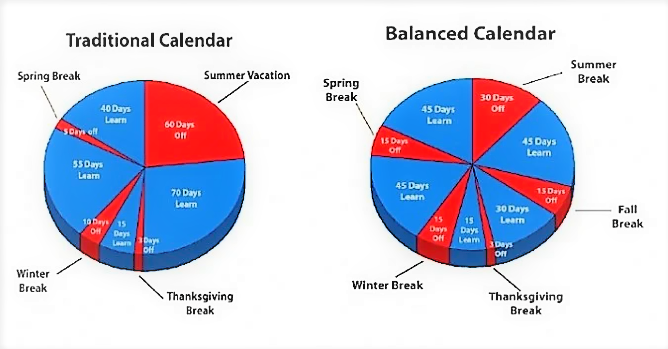45-15 plan: is it beneficial?
February 28, 2023
Typically, people think of the school year as starting in August or at the beginning of September and continuing for 10 months. Students get a summer vacation, as well as breaks in winter and spring. However, some school districts are adopting a year-round schedule, referred to as the 45-15 plan.
On the 45-15 plan, students attend school for 45 days, followed by 15 days off. Schools still close for certain holidays that are built into the calendar. In all, students attend four 45-day sessions over 12 months. Today, ten percent of students in the country attend schools that have adopted year-round schedules in 46 states.
One of the most popular arguments for year-round schooling is that students can avoid the ‘summer slide.’ Shorter breaks can help students retain material learned while school is in session. After a long summer break, students must re-acclimate themselves to the school schedule, their teachers and their peers, as well as to school rules and expectations, homework, and extra-curricular activities such as participation in sports. Due to this, many teachers report that the first month of each school year is spent figuring out what students have retained and reviewing what they have forgotten over the summer break.
Some people believe that shorter breaks, such as the 45-15 system, as opposed to one long summer break, provide both students and teachers with time to relax and regroup. Teachers who work for year-round schools report that it gives them a break when they most need it. The year-round calendar also gives teachers the workdays they need at the times they most need them, such as at the end of a marking period when demands for their time are especially high.
Despite the benefits of year-round school, challenges are inevitable. Parents are concerned that their families would not have enough time to take vacations without a long summer break. The year-round calendar can prove to be a nightmare for parents who have multiple children in school. They might have one child in a year-round school and others in schools that operate on a traditional calendar. Parents can struggle to find times during the year for their whole family.
The 45-15 system also creates difficulties for students who want or need to work in the summer. Year-round schooling, with its shorter and more frequent breaks, can interfere with job opportunities, as well as non-school related sports and activities such as summer camps, parks, and recreation activities. Students who want to attend college classes in the summer are also prevented from doing so if a year-round schedule is in place. Not only will it affect these opportunities for students, but also teachers who might otherwise use the summer break to work towards a higher degree, participate in professional development courses, or have summer jobs of their own.
While debate goes on, many educators and parents do not feel that kids need a full two months away from school, so while the year-round schedule certainly requires an adjustment, the changes can bring in more consistent rest periods, expanded learning opportunities, and a more refreshing approach to education and learning for students, parents and teachers alike.






